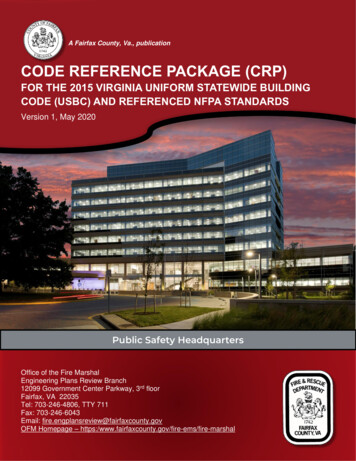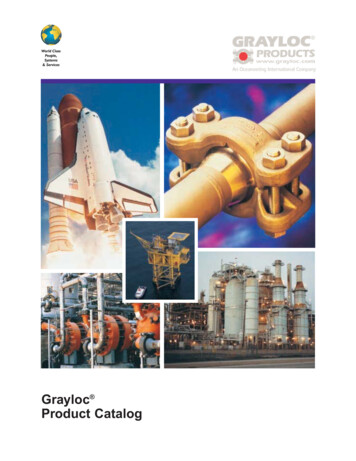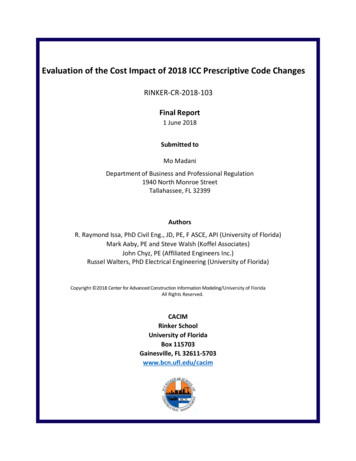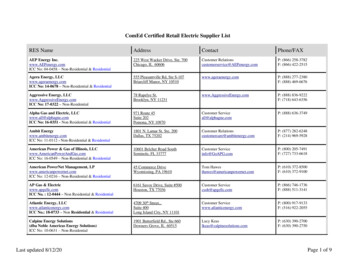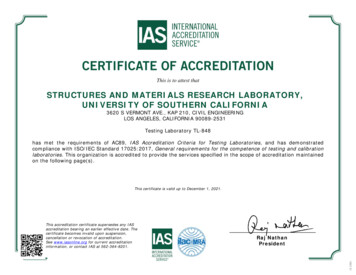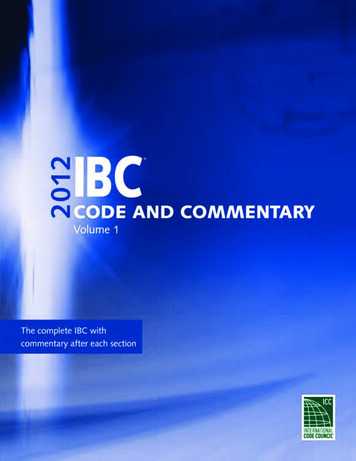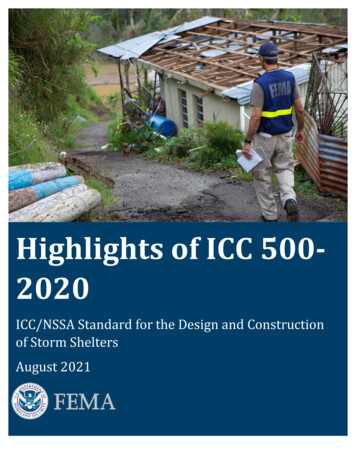
Transcription
Highlights of ICC 5002020ICC/NSSA Standard for the Design and Constructionof Storm SheltersAugust 2021
Highlights of ICC 500-2020Portions of this publication reproduce excerpts from ICC 500-2020 ICC/NSSA Standard for theDesign and Construction of Storm Shelters (ICC 500), International Code Council, Inc.,Washington, D.C. Reproduced with permission. All rights reserved. www.iccsafe.org.
Highlights of ICC 500-2020Table of ContentsAcronyms and Abbreviations . ii1.Introduction. 12.Highlights of the 2020 Edition of ICC 500 . 23.2.1.Application and Administration .22.2.Structural Design and Testing Criteria .32.3.Siting .42.4.Occupant Density, Access, Accessibility, Egress, and Signage .42.5.Fire Safety .42.6.Essential Features and Accessories .52.7.Test Methods .5Significant Changes in the 2020 Edition of ICC 500 . 53.1.Chapter 1, Application and Administration .63.2.Chapter 3, Structural Design and Testing Criteria .83.3.Chapter 4, Siting . 103.4.Chapter 5, Occupant Density, Access, Accessibility, Egress and Signage . 113.5.Chapter 6, Fire Safety . 123.6.Chapter 7, Storm Shelter Essential Features and Accessories . 133.7.Chapter 8, Test Methods for Impact and Pressure Testing . 143.8.NEW Appendix A, Storm Shelter Preparedness and Emergency Operations Plan(SSPEOP) . 15FiguresFigure 1: Design wind speeds for tornado storm shelters .2Figure 2: Design wind speeds for hurricane storm shelters.9i
Highlights of ICC 500-2020Acronyms and AbbreviationsACIAmerican Concrete InstituteAHJauthority having jurisdictionANSIAmerican National Standards InstituteASCEAmerican Society of Civil EngineersIBCInternational Building CodeICCInternational Code CouncilIEBCInternational Existing Building CodeIPCInternational Plumbing CodeIPSimpact-protective systemsIRCInternational Residential CodeISEAInternational Safety Equipment Associationmphmiles per hourNFPANational Fire Protection AssociationNSSANational Storm Shelter AssociationRDPRegistered Design ProfessionalSEIStructural Engineering InstituteSSPEOPStorm Shelter Preparedness and Emergency Operations Planii
Highlights of ICC 500-20201.IntroductionPublished by the International Code Council (ICC ) and the National Storm Shelter Association(NSSA ), the ICC/NSSA Standard for the Design and Construction of Storm Shelters (ICC 500). , is areferenced standard in the International Codes (I-Codes). The ICC, in partnership with the NSSA,formed a national committee in 2003 that developed and released a consensus standard to codifythe design and construction requirements of tornado and hurricane storm shelters. The ICC 500 wasfirst published in the summer of 2008 and updated in December of 2014 and 2020. ICC 500provides:the minimum requirements to safeguard the public health, safety, andgeneral welfare relative to the design, construction, and installation ofstorm shelters constructed for protection from tornadoes, hurricanes,and other severe windstorms. This standard is intended for adoption bygovernment agencies and organizations for use in conjunction withapplicable codes to achieve uniformity in the technical design andconstruction of storm shelters (ICC 500 Section 101.1).ICC 500 applies to the design, construction, installation, and inspection of community andresidential storm shelters. Residential storm shelters serve occupants of dwelling units and have anoccupant capacity not exceeding 16 people. Community storm shelters are storm shelters that arenot residential storm shelters; they may include shelters intended for use by the general public, byoccupants of a specific campus or building, or a combination of both. Storm shelters are permitted tobe either separate, detached buildings, or enclosed or partially enclosed within a host building.Since the 2009 editions of the ICC’s International Residential Code (IRC) and International BuildingCode (IBC), ICC 500 has been referenced as the governing standard for the design and constructionof storm shelters. Additionally, Section 423 of the 2015, 2018, and 2021 editions of the IBCrequires new buildings with certain uses or occupancies and geographic locations to be built with astorm shelter. The following structures must include a storm shelter constructed in accordance withICC 500 when located in a 250 mph wind speed zone for tornadoes per Figure 304.2(1) of ICC 500(refer to Figure 1): 911 call stations Emergency operations centers Fire, rescue, and ambulance stations Police stations K-12 school buildings with an occupant load of 50 or more, with certain exceptions1
Highlights of ICC 500-2020Further, the 2018 and 2021 editions of the International Existing Building Code (IEBC) provide stormshelter requirements for additions to existing buildings that parallel the storm shelter requirementsfor new buildings in IBC Section 423.SOURCE: ICC 500 (2020) FIGURE 304.2(1); USED WITH PERMISSIONFigure 1: Design wind speeds for tornado storm sheltersICC 500 sets forth requirements for a range of topics related to the design and construction of stormshelters, including administration; structural design and testing; siting; occupant density, access,accessibility, egress, and signage; fire safety; essential features and accessories; and test methodsfor impact and pressure testing. Highlights of ICC 500 (2020 edition) are described below.2.Highlights of the 2020 Edition of ICC 5002.1.Application and Administration ICC 500 specifies the information required on submittal documents, which must be preparedand sealed by a registered design professional with every permit application. The standard alsoincludes provisions for quality assurance plans, contractor responsibilities, peer review, specialinspection, and structural observations. New requirements (described in the following section) have been added to address ownerresponsibilities for new shelters and the evaluation, maintenance, and repair of existing shelters.2
Highlights of ICC 500-2020 Listing and labeling requirements are provided. Labels indicating compliance with the standardare mandatory on impact-protective systems (IPS). The requirements also dictate whatinformation must be shown on labels.2.2.Structural Design and Testing Criteria The standard requires testing where the capacity of the storm shelter envelope cannot bedetermined by engineering calculations. Loads and load combinations derived from the American Society of Civil Engineers / StructuralEngineering Institute (ASCE/SEI) standard ASCE 7, Minimum Design Loads and AssociatedCriteria for Buildings and Other Structures (2016) are required for storm shelter design. Windload parameters that are modified by ICC 500 for all shelters include wind speed, exposurecategory, directionality factor, and enclosure classification. For tornado storm shelters, changesin internal pressures due to atmospheric pressure change and topographic effects must also beconsidered. Aside from wind loads, ICC 500 provides requirements for rain loads, floor live loads, roof liveloads, hydrostatic loads, and flood loads that differ from ASCE 7. Requirements for shielding of shelters from host and adjacent buildings and for the connectionsbetween a storm shelter and its host building are specified. Storm shelter designers are notpermitted to lessen wind loads or wind-borne debris impacts that may result from shielding bythe host (or adjacent) buildings, because the other building may fail. Further, the storm sheltermust be able to resist the maximum forces that could be transmitted through connectionsbetween the host building and the shelter. Resistance to wind-borne debris hazards is addressed through missile impact testingrequirements. Representative test missile sizes are a function of the shelter’s designated stormtype, whereas test missile speeds vary with storm type, shelter design wind speed, andorientation (vertical or horizontal) of the shelter assembly or component. Laydown and falling debris hazard requirements have been revised in the 2020 edition. ICC 500now defines laydown radius and fall radius and requires storm shelters to be designed to resistthe impact loads from potential laydown and falling debris hazards. It also requires impact loadsfrom these hazards to be considered one at a time additively with the uniform roof live load. Limitations on joints, gaps, voids, and penetrations in the storm shelter envelope are provided.Where the limitations are exceeded, opening protection is required. Foundations and slabs that support a residential storm shelter within one- or two-familydwellings must be designed in accordance with either American Concrete Institute (ACI) 318,Building Code Requirements for Structural Concrete, or ACI 332, Code Requirements forResidential Concrete and Commentary, for all applicable loads of ICC 500 Chapter 3. All other3
Highlights of ICC 500-2020storm shelters must comply with ACI 318 for all applicable loads of ICC 500 Chapter 3. Anexception for existing slabs supporting heavy storm shelters is included.2.3.Siting Criteria based on storm shelter type and location of the shelter in three defined flood hazardareas are provided so users can determine whether Chapter 4 flood design requirements andminimum floor elevations apply. Flood siting restrictions that apply to all storm shelters are provided. An additional sitingrestriction is maximum travel distance for residential tornado storm shelters. Also, a newreference is provided to IBC Section 423 for maximum travel distance to community stormshelters that are required for educational occupancies.2.4.Occupant Density, Access, Accessibility, Egress, and Signage Storm shelter occupant density tables with minimum usable floor area per occupant are providedalong with criteria for determining usable floor area. Provisions for community storm shelter access and egress include accessibility, egress doors,emergency escape openings, and requirements unique to multi-story shelters. Simplified accessand egress requirements are provided in a separate section for residential storm shelters. Bothsections reference a new free-standing section for vertical access and egress requirementswhere emergency stairs, ladders, alternating tread devices, or overhead hatches are used tomeet access and egress requirements. Latching mechanism requirements for IPS are provided to address engagement of the system,multi-latching systems, and operable hardware on the unprotected side. Storm shelter signage requirements are provided to ensure the protected areas are easilyidentifiable.2.5.Fire Safety Where required for the normal use of the storm shelter, fire protection systems are not requiredto be protected from the storm shelter design event. Fire-resistant rated construction requirements (including exceptions) are provided for communitystorm shelters. Fire extinguisher requirements are provided for community storm shelters.4
Highlights of ICC 500-20202.6.Essential Features and Accessories Tables showing the number of required water closets and lavatories are provided for bothhurricane and tornado storm shelters. Hurricane shelters are also required to provide asanitation support method capable of supplying water and containing waste. Drinking water requirements per occupant are provided for community hurricane storm shelters. Rainfall drainage requirements are provided for hurricane storm shelters and can be calculatedusing either the rainfall rate maps given in Chapter 3 or approved local weather data. Natural and mechanical ventilation requirements are covered for tornado and hurricane stormshelters. Tornado storm shelters are permitted to be ventilated by natural or mechanical means.Hurricane shelters must have natural ventilation, and those with a design occupant capacity of50 or more must also have mechanical ventilation. Requirements for other storm shelter critical support systems, such as emergency lighting,standby lighting, and standby power, are also covered in the standard. To maintain functionalitythroughout the design storm event, storm shelter critical systems located outside the shelterenvelope must be protected from wind loads, debris impact, and flood loads (where applicable)to the same level as the storm shelter.2.7.Test Methods The standard specifies missile impact and pressure (static and cyclic) testing requirements forstorm shelters and storm shelter components. Pass/fail criteria for the required storm shelter testing is also provided.3.Significant Changes in the 2020 Edition of ICC 500The 2020 edition of ICC 500 features several overall changes intended to enhance consistency andorganization within the standard and provide better correlation with the applicable codes.Cumulatively, the following revisions should improve user experience for designers, code officials,owners/operators, builders/contractors, and ultimately, the storm shelter occupants. Similar to current ICC codes, a ‘General’ section has been added to the beginning of eachchapter to provide scope and general provisions that apply to all subsequent sections as needed. Appendix A (Storm Shelter Preparedness and Emergency Operations Plan [SSPEOP]) has beenadded to complement new requirements on owners’ responsibilities in Chapter 1. Although most chapters have been reorganized to promote clarity and parallel constructionacross sections, the reorganizations of Chapters 5 and 7 are likely the most substantial.5
Highlights of ICC 500-2020 For better overall organization, provisions for ‘Weather protection’ and ‘Shelter grounding andbonding’ have been moved from Chapter 3 (Structural Design and Testing Criteria) to Chapter 7(Storm Shelter Essential Features and Accessories). To improve alignment with the IBC and other applicable I-Codes, occupant-driven triggers forcommunity storm shelter requirements have been changed from “greater than 50 occupants” to“50 or greater occupants.” As a result, the threshold for peer review, fire separation exceptions,and multiple Chapter 7 requirements is lowered by 1.The sections below provide a brief representation of the most significant changes by chapter.3.1.Chapter 1, Application and Administration Section 104, Construction and Occupancy: New Section 104.3.2 requires application of ICC 500hurricane shelter provisions for storm shelters located on islands of the Western North PacificOcean and South Pacific Ocean, where hurricanes are called typhoons and cyclones, and inAlaska, where extra-tropical storms have hurricane-like effects and duration. Section 106, Submittal Documents:oSection 106.1, General: Storm shelter submittal documents, formerly referred to as“construction documents,” are now required for every permit application and must be sealedby a Registered Design Professional (RDP). Previous editions of the standard were silent onqualifications for the individual(s) who prepared the submittal documents, whether sealswere required, and whether a single submittal could be applied to multiple permitapplications. Previous editions of the standard only required preparation of constructiondocuments “where required by the authority having jurisdiction.”oSection 106.2.1 Design Information: New design information required to be included withsubmittal documents includes (1) use of the community shelter (by the general public,building occupants, or combination of both), and (2) design wind pressure and applicablezones, with dimensions needed for specification of components and cladding of the shelterenvelope. Also, additional details are required for shelters subject to the flood siting andelevation provisions of Section 402.1 and for minimum foundation capacity requirements.Lastly, calculations are required to support the usable floor area and minimum venting area. NEW Section 108, Owner’s Responsibility: The new section requires storm shelter owners to (1)submit a statement of responsibility for ongoing operations and maintenance of the facility withthe application for permit, and (2) submit a SSPEOP, which is needed for approval of thecertificate of occupancy. Prior to the 2020 edition, ICC 500 did not address ongoing operationsand maintenance or preparedness and emergency operations plans for storm shelters. Section 109, Peer Review: Relocated from Section 106.1.1 and 106.1.2 to its own free-standingsection (109), peer review requirements have been expanded as follows:6
Highlights of ICC 500-2020oSection 109.2, Peer Review: The 2014 edition of the standard required peer review ofChapters 3, 5, 6, and 7; the 2020 edition adds peer review requirements for Chapter 4 andSections 106, 107, 110, and 111. Further, to discourage potential peer reviewer bias, thesection now assigns the responsibility of hiring the peer reviewer to the storm shelter’sowner.oNEW Section 109.3: Disclosure: In support of peer reviewer independence, this new sectionrequires the project’s peer reviewers to disclose potential conflicts of interest to the authorityhaving jurisdiction (AHJ) and owner or owner’s representative. ICC 500-2014 included adefinition of ‘peer review’ that indicated the reviewer(s) should be independent of the RDP inresponsible charge of storm shelter design. However, definitions are not enforceable, so thedefinition was removed, and the new section was added to Chapter 1 with the responsibilityof disclosure placed on proposed reviewers.oNEW Section 109.4, Qualifications: The new section requires peer reviewers to providewritten documentation to the owner or owner’s representative that demonstrates relevantexperience and training for the chapters and/or sections of ICC 500 that they propose toreview. Previous editions of the standard were silent on peer reviewer qualifications.oNEW Section 109.5.1, Changes: The new section requires the storm shelter’s RDP inresponsible charge to submit to the peer reviewer any design changes to the main wind forceresisting system or components and cladding that are made after submittal of the peerreview report but before issuance of permits. If the peer reviewer determines the reportrequires amending to address the change, then the amended report must be resubmitted.Previous editions of the standard were silent on whether design changes made aftersubmittal of the report were subject to peer review. Based on evidence of differingjurisdictional interpretations, the standard committee decided clarification was needed in ICC500-2020. Section 112, Listing and Labeling: Storm shelter labeling requirements have been relocated fromSection 108.2 to a new free-standing section that also requires listing of storm shelter IPS todenote compliance with the standard. The section has also added ‘Marking’ requirements thatspecify the minimum information shown on each label. NEW Section 113, Evaluation, Maintenance and Repairs: The new section establishes criteria forthe evaluation, maintenance, and repair of existing community storm shelters. Evaluation criteriafor storm shelter envelopes and IPS are provided along with triggers and requirements for repairsof damaged or missing components and replacement of assemblies. Recordkeeping protocolsare also included. Prior to the 2020 edition, ICC 500 did not address the evaluation,maintenance, and repair of existing community storm shelters.7
Highlights of ICC 500-20203.2.Chapter 3, Structural Design and Testing Criteria Section 302, Load Combinations: Sections 302.2, Strength Design, and 302.3, Allowable StressDesign, no longer reference ASCE 7 for load combinations but have been customized for stormshelters while maintaining consistency with ASCE 7. Section 303, Loads: oSection 303.1, Rain loads: Subsection 303.1.1, Rainfall rates, has been revised to includenew 100-year, 1-hour rainfall rate maps for Alaska, Hawaii, and the Western United States.Additionally, the section now allows for the 100-year, 1-hour rainfall rate to be determinedfrom the referenced maps or from “approved local weather data.” Previous editions of thestandard only provided rainfall rate maps for the eastern and central United States and didnot provide the option to determine rainfall rates using approved local weather data.oNEW Section 303.2, Floor live loads: This new section adds floor live loads to better reflectoccupant density per storm type. Previous editions of ICC 500 did not specify modificationsfor storm shelter live floor loads.oSection 303.3, Roof live loads: NEW Subsection 303.3.1, Wheel loads, has been added forstorm shelters subject to vehicle loads (typically in-ground shelters). Where applicable,vehicle loads are required to be determined in accordance with the referenced codes (IBC orIRC) or standard (ASCE 7). Previous editions of ICC 500 did not require consideration ofwheel loads for the structural design of storm shelters.Section 304, Wind Loads: New and updated storm shelter design wind speed figures arereferenced in Section 304.2, Design wind speed, as follows:oThe hurricane storm shelter design wind speed map, Figure 304.2(2) of ICC 500 (refer toFigure 2 below), has been updated. The current hurricane storm shelter design wind speedmap still reflects the 10,000-year Mean Recurrence Interval used in the previous twoeditions but is based on further refinements to the hurricane model and updated climatologythat were used to develop the revised wind speed maps currently proposed for inclusion inASCE 7-22. Unlike the previous editions in which models included historical hurricane trackand landfall data from 1900 to 2006, the updated model includes data through the 2018hurricane season.The tornado shelter design wind speed map contours are unchanged from the previouseditions and are shown above in Figure 1.oThe new hurricane storm shelter design wind speed map includes the table that lists thedesign wind speeds for Hawaii and U.S. island territories that was erroneously included ontornado storm shelter and safe room wind speed maps in previous editions. Also, theNorthern Mariana Islands have been added to the above-described table.8
Highlights of ICC 500-2020oThe storm shelter design wind speeds for Alaska have been moved from the tornado stormshelter design wind speed map to a separate design wind speed map in the latest edition ofICC 500. Aside from the separate design wind speed map, the standard now specifies thatAlaskan storm shelters comply with hurricane shelter criteria as described above in theChapter 1 (Section 104) highlights.Figure 2: Design wind speeds for hurricane storm shelters Section 305, Debris Hazards:oSection 305.3, Laydown and falling debris hazards: The revised section adds criteria fordetermining whether laydown or falling debris hazards must be applied to the shelter andremoves considerations for rollover and collapse loading. Previous editions required thatlaydown, rollover, and collapse hazards be considered by the design professional only whendetermining shelter siting.oSection 305.3.3, Impact loads: This new section requires a minimum impact load factor of2.0 (times the estimated weight of the hazard) where laydown or falling debris hazards mustbe applied to the shelter.Section 306, Component Design and Testing:9
Highlights of ICC 500-2020oSection 306.4.1.3, Anchorage for IPS: The section now specifies anchorage must bedesigned to resist shear and pull-out for wind loads in accordance with Section 304 forinstallations inconsistent with manufacturer’s listing. Previous editions of the standardrequired that shear and pull-out design loads be determined in accordance with “acceptedengineering practice,” which led to varying interpretations.oSection 306.5, Joints, gaps or voids in storm shelter envelope: This existing section adds anew exception for precast concrete panel joints with maximum widths up to ¾ inch forminimum 6-inch-thick wall panels or 4-inch-thick roof panels. Limitations on joints, gaps, andvoids in the shelter envelope were added to the 2014 edition and included an exception withequal tolerances for masonry, concrete, and precast concrete panel construction joints.Missile impact test results for precast concrete panel joints were provided to support thefree-standing exceptions that are based on maximum allowable joint widths.oSection 306.6, Penetrations of storm shelter envelopes by mechanical, electrical andplumbing systems: The threshold for circular penetrations in the storm shelter enveloperequiring IPS increased from a diameter of 2-1/16 inches to 2-1/2 inches to allow commonlysized plumbing vent pipes to be used without IPS.3.3.Chapter 4, Siting Former Section 402, Hazardous Materials: The Chapter 4 section on hazardous materials wasdeleted because of concerns that requirements in the first two editions could potentially preventor significantly delay shelter construction in urban and suburban areas. Section 402, Flood Criteria:1oNEW Section 402.1, General:1 New section provides new Table 402.1, “Storm SheltersRequired to Comply with Section 402” so users can quickly determine if the flood criteria ofSection 402 will apply to any type of storm shelter based on whether it is located in the 100year flood hazard area, 500-year flood hazard area, or the storm surge flood hazard area.The section was added in response to shelter designers who indicated the existingrequirements were often interpreted as applying to all shelters regardless of location withrespect to flood hazard area.oNEW Section 402.3, Determining flood elevations and floodway: This new section providesan IBC-consistent approach for determining flood elevations and the location of floodwayswhere not included on the adopted flood hazard map. The new provisions replace the “floodof record” approach for determining minimum flood elevations where detailed information isRefer to FEMA Funding Criteria in Part B of FEMA P-361, Safe Rooms for Tornadoes and Hurricanes: Guidance forCommunity and Residential Safe Rooms, Fourth Edition, April 2021, for amendments to this standard requirement.10
Highlights of ICC 500-2020not available on the adopted flood hazard map and correlates better with the model codesand ASCE 24, Flood Resistant Design and Construction. oSection 402.5, Storm shelter siting: 2 This updated section covers all storm shelters insteadof only scoping community shelters as in previous editions. Further, Coastal A Zones havebeen added to the list of restricted high-risk flood areas.oSection 402.6, Minimum floor elevations of storm shelters: 3 This section has been expandedto cover hurricane and tornado shelters separately for community and residential shelters.New criteria have been added for community tornado shelters in the identified flood hazardareas to allow: (1) unregulated or lower floor elevations for shelters not classified as RiskCategory IV (per IBC Table 1604.5), and (2) exceptions for dry floodproofing and stormshelters added to existing buildings.Section 403, Maximum travel distance for tornado shelters: Formerly entitled “Siting Proximityfor Residential Shelters,” Section 403 has been expanded to include Section 403.1 (Communitytornado shelters in educational occupancies), which references IBC Section 423 requirementsfor consistency. The requirements for residential shelters are unchanged from the 2014 edition.3.4. 23Chapter 5, Occupant Density, Access, Accessibility, Egressand SignageSection 502, Occupant Density in Community Storm Shelters:oSection 502.2, Design occupant capacity: For better correlation with the model codes, thenew term “design occupant capacity” is introduced to replace most uses of “occupant load”in the standard. New subsections have been added to distinguish between “assigned” and“calculated” design occupant capacity, but notably, storm shelter “occupant density” (akausable floor area per occupant) requirements are unchanged.oSection 502.4, Provided usable floor area: Both prescribed methods for calculating usablefloor area are unchanged from previous editions, but the standard now permits combiningthe two methods to determine the overall storm shelter usable floor area (i.e., users candecide to apply method one to some areas and method two to others).oSection 502.5, Tornado shelter usable floor area: In accordance with the new definitionprovided in Chapter 2, “usable floor areas” exclude occupant support areas. However, newSection 502.5 permits specified occupant support areas of community tornado shelter toiletrooms to be considered usable floor areas. The specified areas include single-occu
Building Code Requirements for Structural Concrete, or ACI 332, Code Requirements for Residential Concrete and Commentary , for all applicable loads of ICC
